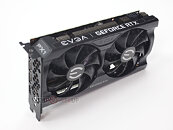- Joined
- Oct 9, 2007
- Messages
- 47,775 (7.41/day)
- Location
- Dublin, Ireland
| System Name | RBMK-1000 |
|---|---|
| Processor | AMD Ryzen 7 5700G |
| Motherboard | Gigabyte B550 AORUS Elite V2 |
| Cooling | DeepCool Gammax L240 V2 |
| Memory | 2x 16GB DDR4-3200 |
| Video Card(s) | Galax RTX 4070 Ti EX |
| Storage | Samsung 990 1TB |
| Display(s) | BenQ 1440p 60 Hz 27-inch |
| Case | Corsair Carbide 100R |
| Audio Device(s) | ASUS SupremeFX S1220A |
| Power Supply | Cooler Master MWE Gold 650W |
| Mouse | ASUS ROG Strix Impact |
| Keyboard | Gamdias Hermes E2 |
| Software | Windows 11 Pro |
When NVIDIA launched the GeForce RTX 3050 "Ampere" based on the "GA106" silicon with specifications that could be fulfilled with the smaller "GA107," we knew that the company could eventually start making RTX 3050 boards with the smaller chip, and they did. Igor's Lab reports that RTX 3050 cards based on GA107 come with a typical board power of 115 W, which is about 11 percent lower than that of the GA106-based cards (130 W).
There's no difference in specifications between the two cards. Both feature 2,560 CUDA cores across 20 streaming multiprocessors, 80 Tensor cores, 20 RT cores, and a 128-bit wide GDDR6 memory interface, holding 8 GB of memory that ticks at 14 Gbps data-rate (224 GB/s bandwidth). The GA106 and GA107 ASICs share a common fiberglass substrate, and hence are pin-compatible for the convenience of board partners, with the latter having a smaller die, so any cooling solution designed for the launch-day RTX 3050 should work perfectly fine with those based on GA107.

View at TechPowerUp Main Site
There's no difference in specifications between the two cards. Both feature 2,560 CUDA cores across 20 streaming multiprocessors, 80 Tensor cores, 20 RT cores, and a 128-bit wide GDDR6 memory interface, holding 8 GB of memory that ticks at 14 Gbps data-rate (224 GB/s bandwidth). The GA106 and GA107 ASICs share a common fiberglass substrate, and hence are pin-compatible for the convenience of board partners, with the latter having a smaller die, so any cooling solution designed for the launch-day RTX 3050 should work perfectly fine with those based on GA107.

View at TechPowerUp Main Site



